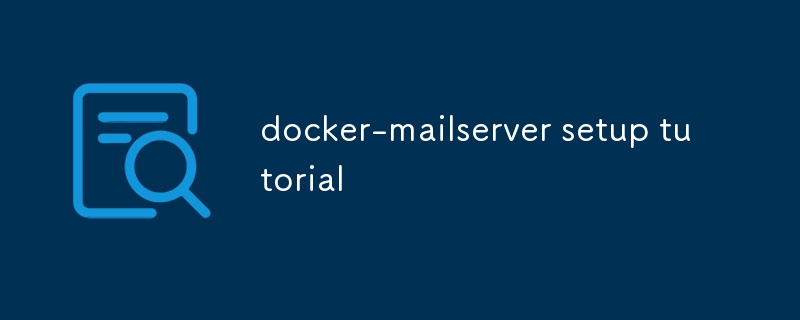
This article provides a comprehensive guide to setting up and securing a Docker mailserver with a custom domain. It addresses challenges, including password security, TLS/SSL encryption, rate limiting, and two-factor authentication. The article also

docker run -d --name mailserver mailserver/postfix.docker run -d --name mailserver mailserver/postfix.docker exec -it mailserver bash.nano /etc/postfix/main.cf.Update the "myhostname" and "mydomain" variables with your desired values:
myhostname = your-hostname.example.commydomain = example.comservice postfix restart to apply changes.sudo nano /etc/hosts.your-ip-address your-hostname.example.com./var/log
docker exec -it mailserver bash.nano /etc/postfix/main.cf.myhostname = your-hostname.example.commydomain = example.comservice postfix restart to apply changes.sudo nano /etc/hosts.🎜🎜Add a new line with the following format: your-ip-address your-hostname.example.com.🎜🎜Save and exit the hosts file.🎜🎜Now, your custom domain should be set up for the mailserver.🎜🎜🎜What Security Measures Should I Implement for My Docker Mailserver?🎜🎜🎜🎜Use strong passwords:🎜 Make sure to set strong and unique passwords for your mailserver account and database.🎜🎜🎜Enable TLS/SSL:🎜 Encrypt communication using TLS/SSL certificates to protect against eavesdropping and data interception.🎜🎜🎜Implement rate limiting:🎜 Use rate limiting to control the number of emails that can be sent from your mailserver within a specific time interval. This can help prevent spam and abuse.🎜🎜🎜Enable two-factor authentication (2FA):🎜 Add an extra layer of security by requiring users to provide a second form of authentication, such as a code sent to their phone, when logging in.🎜🎜🎜Keep software up-to-date:🎜 Regularly update your mailserver software and operating system to patch security vulnerabilities.🎜🎜🎜How Can I Troubleshoot Common Issues with My Docker Mailserver Setup?🎜🎜🎜🎜Check the logs:🎜 Check the mailserver logs, typically found in /var/log, for any error messages that may help identify the issue.🎜🎜🎜Verify DNS settings:🎜 Ensure that the DNS records for your custom domain are configured correctly and point to your mailserver's IP address.🎜🎜🎜Restart the mailserver:🎜 Sometimes, restarting the mailserver service can resolve temporary issues.🎜🎜🎜Check firewall settings:🎜 Make sure that the firewall on your host machine allows connections to the mailserver's ports (usually 25, 110, 143, 587, and 993).🎜🎜🎜Try using a different email client:🎜 If you're experiencing issues sending or receiving emails, try using a different email client to rule out any client-side problems.🎜🎜The above is the detailed content of docker-mailserver setup tutorial. For more information, please follow other related articles on the PHP Chinese website!
 What to do if the specified module cannot be found
What to do if the specified module cannot be found
 What does independent direct connection mean?
What does independent direct connection mean?
 How about Ouyi Exchange?
How about Ouyi Exchange?
 How to set up ftp server
How to set up ftp server
 Win10 My Computer Icon Retrieval Tutorial
Win10 My Computer Icon Retrieval Tutorial
 Introduction to monitoring equipment of weather stations
Introduction to monitoring equipment of weather stations
 java environment variable configuration
java environment variable configuration
 What are the uses of mysql
What are the uses of mysql




